How Relational and Transactional Services Work Together
The Civic Centre was busier than Paula had expected. She hesitated in the doorway, clutching her bag tightly. Her eyes darted around the atrium, taking in the reception desk, the posters on the walls, and the line of people waiting for help.
She waited patiently, and after 20 minutes, she reached the front of the queue.
Rowan, a triage officer from customer services, looked up from the desk and offered a smile. “Next, please,” he called, gesturing for Paula to step forward.
She approached the desk nervously and spoke quietly to avoid being overheard. “Hi,” she said. “I... I’m struggling to pay my council tax bill. I already have too many debts.”
Rowan nodded, his tone reassuring. “You’ve come to the right place. Let’s see how we can help.” He leaned forward slightly, his voice warm but professional. “Here's a ticket to speak to the council tax support team. They might be able to organise an agreement for smaller, more manageable payments. They'll call your number when they’re ready for you. We also work with a charity that specialises in benefits and debt management. They come to the library next door once a week, but their last session was yesterday.”
“Oh,” Paula said softly, her shoulders sinking slightly.
“Not to worry,” Rowan continued cheerfully. He reached for a thin sliver of paper, the edges jagged and frayed. He handed it to Paula. “You can call this number to book an appointment with them. They’ll guide you through everything, step by step.”
Paula took the paper and stared at it for a moment, her thumb tracing the torn edges. “Thanks,” she murmured.
Rowan studied her for a beat. “Is there anything else I can help you with?”
Paula’s chest tightened. She thought of Kieran, his suspensions, the fights at school, and her struggle to adjust her work schedule to be more available at home. She opened her mouth to speak, but the impatient shuffle of the queue behind her caused the words to dissolve before they could escape.
“No,” she said quickly. “That’s all.”
Rowan sensed there was something more, but his attention was divided between Paula and the growing queue now causing havoc with the revolving doors. “Okay,” he said finally. “But if you ever need to talk about anything else, we’re here.”
“Thanks,” Paula said again, clutching the paper tightly. Instead of waiting to speak to the council tax team, she turned to leave. Rowan had already begun his next conversation and didn’t notice.
Outside, the cold air hit her, and she exhaled sharply. She looked down at the number, her thoughts racing. She knew Kieran’s suspensions were a bigger problem than the bills, but talking about them felt impossible.
She slipped the paper into her bag. “Maybe tomorrow,” she thought to herself. “Maybe tomorrow.”
This model doesn’t work for Paula
Whether it’s “one front door” or “no wrong door,” the triage model outlined in the story above (or at least some variation of it) is widely used.
As we’ve outlined in our previous articles, for citizens with complex issues, it rarely works.
Paula needed a conversation with someone in a calm and quiet environment.
A conversation with someone who had the time to ask questions, build trust and start to understand her challenges. With a bit of luck, a more relational approach would have allowed Paula to explain her situation (over time) and enabled the helper to respond holistically.
However, it’s clear from Paula’s story that not all of her needs require a relational approach.
Citizens with complex needs often require access to transactional services. The reverse is also true. Individuals seeking transactional assistance may, upon further engagement, reveal deeper issues requiring relational support.
At the heart of effective service delivery is the ability to integrate transactional and relational services and to ensure residents can access both without falling through the cracks of the system in the process.
In this article, we’ll outline several strategies we’ve tested in three common scenarios, namely:
When someone new presents to a service
When a transactional service uncovers more complex needs
When people receiving relational support also need transactional services
When someone new presents to a service
Many of the problems residents experience, delays, fragmentation, and repeated assessments, stem from how services initially respond to demand.
In many public services, triage and assessments are used as tools for managing demand and navigating internal complexity. These quick, checklist-driven processes are often carried out by less experienced staff and are designed to filter cases efficiently.
However, they rely on flawed assumptions: that the correct diagnosis will always be made at first contact and that every referral will be followed up.
Anyone working with people facing complex challenges knows that reality is different.
For residents like Paula, whose difficulties affect multiple aspects of her life, this system creates delays, increases the risk of being overlooked, and prevents her from getting help when she needs it most.
Before we rethink how relational and transactional services interact, we need to start with a different approach to triage.
Where possible, services should be designed so residents can access the right help without unnecessary triage and other screening.
Where it’s safe and legal, we should reduce the need for triage and assessments altogether.
How?
Clear, consistent information, both online and offline, should make it obvious and intuitive for people to understand where to go and what to expect.
Well-designed spaces can also support this clarity. The design of services should signal their intent: calm, welcoming environments for relational support, and efficient, structured ones for transactional needs.
In other words, residents should be able to navigate services based on the nature of their need—whether it’s straightforward and transactional, or more complex and relational.
For straightforward transactions, such as paying a fine or renewing a licence, residents should be able to complete the process end-to-end quickly, preferably online.
Those with more complex challenges should be able to connect with relational support directly, without jumping through assessment hoops.
Fundamentally, relational and transactional services need different operating models. We’ll unpack this in detail in a future article.
When a transactional service uncovers complex needs
Even with such a system in place, while delivering transactional services, staff may uncover deeper, more complex needs that require additional support.
We’ve found that transactional service teams are most effective at dealing with this situation when they:
Have a basic awareness of other services. They don’t need to know everything, but a general understanding of common challenges residents face in their locality helps them recognise when additional support might be required. The specific needs differ from locality to locality.
Can pull in a relational worker when in doubt. If there’s any doubt about whether someone needs more than a transactional service, the default should be to pull in a relational worker. Paying a parking fine is a simple transactional process. But if a resident says they can’t pay, the reason matters. Are they unwilling, or are they unable?
Build strong links with relational services. Knowing what support is available and having personal connections with relational workers makes it easier to guide residents to the right help. Warm handovers help to ensure people actually get the help they need and don’t have to repeat their story multiple times.
Using warm handovers to avoid people falling through the cracks
The risk of things going wrong is greatest at the point where a referral between transactional and relational services is required.
If Paula, for example, were simply given instructions to contact a relational worker, she might forget or feel too overwhelmed to act on it. Stress makes it harder to process and retain information.
A "warm handover" can make all the difference.
Signposting vs. cold referral vs. warm handover
Unlike a cold referral, where a resident is given a phone number, appointment, or told to wait for contact, a warm handover involves a direct, personal introduction to the next service. Ideally, this happens face-to-face, but it can also be done by phone or over MS Teams.
This approach establishes trust from the start, reduces anxiety and ensures the citizen doesn't need to repeat their story.
Over the past 15 years, we’ve seen how this small change helps people access the support they need more effectively.
When people receiving relational support also need transactional services
Relational services often encounter situations where they need to support citizens in completing a transactional service, such as applying for benefits or doing a statutory assessment.
Workers in these settings are often generalist T-shaped professionals; those with a depth of skill in one area—the vertical line of the “T”—and a breadth of knowledge in several other disciplines—the horizontal line of the “T" (Tim Brown, 2010). But even with this versatility, no single person can meet the full breadth and depth of support that some residents require.
In these circumstances, relational services often need to draw on help from colleagues delivering transactional services.
As we have set out above, handovers between services, whether relational or transactional, are a common point of failure. People can fall through the cracks, support can be delayed, and issues can go unresolved.
But when a handover from a relational service to a transactional one fails, it can undermine the trust that has been carefully built between the citizen and the relational worker. This can set the relationship back, make the citizen reluctant to re-engage and stall whatever progress has been made together.
We’ve found that the following actions can help make this process work more smoothly:
Prepare what can be prepared in advance
When asking for support, it helps if workers prepare thoroughly so their colleagues can act quickly and confidently. This might include:
Gathering and organising information: Providing a clear summary of the citizen’s situation so the next person understands the context straight away.
Doing the heavy lifting: Anticipating what the other professional will need and having it ready. This includes being able to explain any confusing or sensitive aspects of the resident’s history.
Initiate a warm handover
Once prepared, the worker can initiate a warm handover, sharing some of the trust they have built with the citizen.
This connection can be critical to ensuring a smooth transition. Even when a warm handover is not feasible, the helper should have a shortcut into the transactional service, instead of the resident starting at a service triage or assessment.
Keep track
Following up is key. Whether it is checking that action has been taken, unblocking something that is stuck, or simply making sure the citizen has not been lost between services, staying connected helps maintain trust and momentum.
How relational and transactional services work together
Embedding this approach
We believe the strategies outlined here offer practical, testable steps for people working in relational services. They help ease friction at the points where people often fall through the cracks and protecting the trust that’s been built from being eroded by failures that often happen in the transition between services.
But for this way of working to be sustainable, it cannot rely on workarounds or individual effort alone. It requires the right enabling conditions — including leadership, culture, and ways of working that support relational practice. Mark Smith and Joe explore these conditions further in this recent podcast.
It also requires different target operating models that allow relational and transactional services to work in tandem without undermining each other. We will explore these models in more detail in the next article.
A note on the cover image
Karl Popper’s Of Clouds and Clocks (1966) offers a helpful lens for public services. He contrasts “clouds”, messy, unpredictable systems—with “clocks”—orderly, mechanical ones.
While transactional services (like paying council tax) can often function like clocks, relational services (like social care) are more like clouds: complex, fluid, and shaped by human relationships.
Popper's metaphor reminds us that not everything can (or should) be engineered into predictability.
© Basis Ltd. 2025

